|
|

This chapter provides step-by-step instructions for installing, cabling and verifying the installation for:
A detailed description and installation instructions for all of the optional expansion modules for the Catalyst 3000 are described in Chapter 5, "Expansion Components Installation and Configuration."

The Catalyst 3000 and the Catalyst Matrix mount in a standard 19-inch rack or cabinet. The installation area should be near a power source and should have enough room around the front and rear panels for cabling and access to controls. Use the following procedures for the installation of Catalyst Stack equipment.
If you install the Catalyst 3000 in a closed or multi-unit rack, observe the environmental guidelines from Chapter 3, "Preparing for Installation." Observe the following warnings and use the following steps for a rack or cabinet installation.
 | Warning Do not stack the chassis on any other equipment. If the chassis falls, it can cause severe bodily injury and equipment damage. |
 | Warning To prevent bodily injury when mounting or servicing this unit in a rack, you must take special precautions to ensure that the system remains stable. The following guidelines are provided to ensure your safety: |
The following steps describe how to mount the Catalyst 3000 or Catalyst Matrix in a rack or cabinet. Only fixed brackets are supplied with these units. If you want to install a sliding pull-out mount, you will need to provide the extra mounting hardware.
Step 1 For this step, use the L-shaped mounting brackets and four 8-mm M4 screws that are supplied with the units. With a Phillips (cross-head) screwdriver, attach the two L-shaped mounting brackets to both sides of the Catalyst 3000 or the Catalyst Matrix with two each 8-mm M4 screws (see Figure 4-2). The position of the brackets are the same on the Catalyst Matrix.

Before starting the next step, be sure you have the proper hardware for mounting the unit to your cabinet or rack.
Step 2 Position the Catalyst 3000 or the Catalyst Matrix in the rack or cabinet and slide it up or down until the rack holes line up with the bracket holes. Attach the Catalyst 3000 to the rack with appropriate mounting screws (see Figure 4-3).
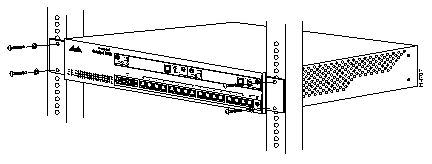
 | Caution Due to weight constraints, place no more than one unit (or the equivalent weight of other equipment) directly on top of another chassis. More than one unit on top of another unit may cause damage to the lower unit. |
The Catalyst 3000 should be mounted in an appropriate mounting rack, but if the situation warrants, such as a shortage of rack space or location constraints, the Catalyst 3000 can be surface mounted. The unit operates at a low noise level, which makes it suitable for a work area or almost anywhere with a large enough flat surface, such as a table or desktop. Simply place the unit on a clear and level location. Leave enough room around the unit for ventilation and access to the controls and cable connectors.
There are two Catalyst Stack configurations.
How to cable the Catalyst Stack equipment is described in the next two sections. The first section explains connecting two Catalyst switches back-to-back. The next section describes how to connect Catalyst switches to the Catalyst Matrix.
To connect two Catalyst 3000 series switches together, an installed WS-X3004 module must be in the expansion slot in the back of each Catalyst switch. (See Figure 4-4.) For a description of how to install the WS-X3004 rear expansion module into the Catalyst 3000 see Chapter 5, "Expansion Components Installation and Configuration" for the section, "Installing WS-X3004 Stack Port (Rear) Expansion Module." Observe the following statements and cautions and use the following steps to install two Catalyst switches in a back-to-back configuration.
Step 1 Connect one end of the Stack port cable to the Stack port (of the WS-X3004 module) on one Catalyst switch. It does not matter which end of the cable to use. Either end of the Stack port cable can be connected to either one of the Catalyst switches.
Step 2 Connect the other end of the cable to the Stack port on the other Catalyst switch.
The following illustrations, Figure 4-4 and Figure 4-5, show how two Catalyst switches are cabled together. (The cable connector is shown at an angle for illustration purposes.)


Up to eight Catalyst switches can be connected to a Catalyst Matrix. For a detailed description of the Catalyst Matrix see Chapter 5, "Expansion Components Installation and Configuration."
This configuration requires a Catalyst Matrix and a Stack port cable and a WS-X3004 module for each Catalyst switch. The connection is made through one of the eight I/O Stack ports on the back panel of the Catalyst Matrix to the single I/O Stack port on the WS-X3004 installed in the back of each Catalyst switch. Use the following instructions (after mounting the Catalyst switches and Catalyst Matrix in a rack or cabinet) to cable the units together.
Step 1 Attach one end of the Stack port cable to Port 1 (recommended port to use first) on the Catalyst Matrix. (See Figure 4-6.) It does not matter which end of the cable is used and it does not matter if the Catalyst switch or Catalyst Matrix is powered on or off.
 | Caution When installing the Stack port cable connector, keep the connector straight as you insert it into the Stack port connector. Inserting the connector at an angle may cause bent pins. (The cable connector in the following figures are shown at an angle for illustration purposes only.) |

Step 2 Attach the other end of the cable to the WS-X3004 Stack Port connector on the back of a Catalyst switch (see Figure 4-7). Repeat these steps for each Catalyst switch using the next highest numbered port on the Catalyst Matrix.

Before you apply power, inspect the equipment thoroughly. Verify that all cables are installed correctly. Check their routing, so they are not damaged or create a safety hazard. Be sure all equipment is mounted properly and securely.
The following figure, Figure 4-8, is an illustration of several Catalyst switches cabled to a Catalyst Matrix
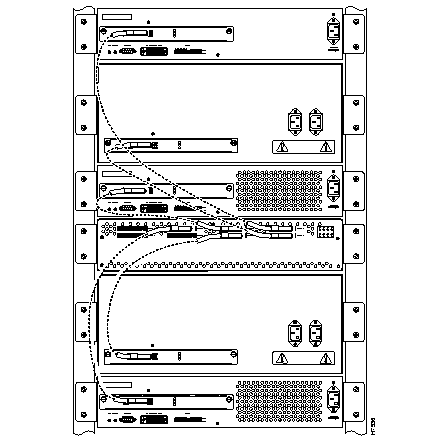
 | Warning Read the installation instructions before you connect the system to its power source. |
 | Warning This unit might have more than one power cord. To reduce the risk of electric shock, disconnect the two power supply cords before servicing the unit. |
 | Warning This product relies on the building's installation for short-circuit (overcurrent) protection. Ensure that a fuse or circuit breaker no larger than 120 VAC, 15A U.S. (240 VAC, 10A international) is used on the phase conductors (all current-carrying conductors). |
 | Warning This device is designed to work with TN power systems. |
 | Warning This equipment is intended to be grounded. Ensure that the host is connected to earth ground during normal use. |
 | Warning Care must be given to connecting units to the supply circuit so that wiring is not overloaded. |
 | Warning A voltage mismatch can cause equipment damage and may pose a fire hazard. If the voltage indicated on the label is different from the power outlet voltage, do not connect the chassis to that receptacle. |
 | Caution There are no user serviceable parts inside the Catalyst 3000. Any internal upgrades or service should be performed by Qualified Personnel ONLY. |
Use the following steps to power on your Catalyst Stack units:
Step 1 Ensure that you are using the correct power source.
Step 2 Using the supplied power cable, plug the female end of the cable into the AC receptacle on the Catalyst 3000 or each Catalyst Matrix module.
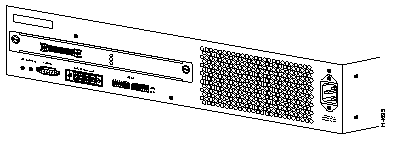
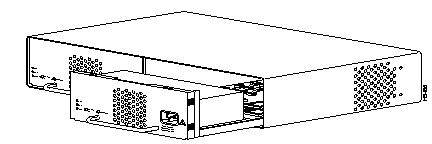
Step 3 Plug the male end of the power cord(s) into a properly grounded electrical outlet.
Step 4 Verify that the power (PWR) LED is on for each module in the Catalyst Matrix. (For the Catalyst Matrix LEDs, see the section "Catalyst Matrix Control Panels" in Chapter 5.) For the Catalyst 3000, check that the PWR LED on the front panel is on. If the PWR LED is not on, make sure the power source is working properly. If the outlet is working, but the power LED and the fans are not on, see Chapter 10, "Troubleshooting."
Step 5 When the Catalyst 3000 powers on, observe the self-test diagnostic that the unit runs for approximately 6-8 minutes. The DIAG LED on the front panel is on for the duration of the test, turning off when the self-test is complete.
Step 6 If at any time the FAULT LED turns on or is flashing, see Chapter 10, "Troubleshooting."
There is one AUI/UTP port, 15 UTP (Unshielded Twisted Pair) ports and two expansion module ports on the front panel of each Catalyst 3000. The UTP ports are 10BaseT using RJ-45 connectors. Use these ports to connect to computers, hubs, servers, and other network devices, or to a network backbone. Figure 4-11 shows examples of Ethernet switches, devices, and networks connected to the Catalyst 3000 10BaseT ports. Figure 4-12 shows examples of Ethernet switches, devices, and networks connected to the Catalyst 3000 Fast Ethernet expansion module ports.
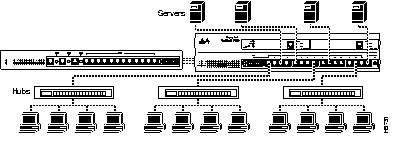
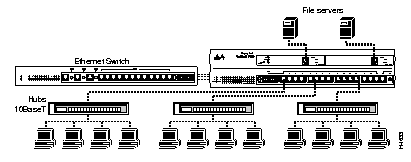
MDI (Media Dependent Interface, or "straight cable") is the IEEE 10BaseT standard for the UTP cable interface. For two 10BaseT devices to communicate with each other, the transmitter of each device must be connected to the receiver of the other device. You can achieve this connection by using a crossover cable, or by using a port that implements the crossover internally. Ports that implement the crossover internally are called MDI-X; "X" stands for crossover.
UTP ports 1 through 15 on the Catalyst 3000 are always MDI-X mode.
When connecting devices that have the same port type, that is, both are MDI or both are MDI-X, use a cross-over cable. For example, when connecting hubs and concentrators that have MDI-X ports to the MDI-X ports on the Catalyst 3000, use a cross-over cable.
When connecting devices that have different port types, that is, one is MDI and one is MDI-X, use a straight cable. For example, servers, PCs, routers, bridges or similar equipment use MDI type ports, therefore use a straight cable to connect these MDI ports to the MDI-X ports on the Catalyst 3000.
See the pinouts in "Appendix A" if a crossover cable needs to be made.
Port 16 can be set on the Catalyst 3000 to either MDI or MDI-X by using the push-button to the right of that port. Refer to the following table (Table 4-1) and illustration (Figure 4-13) to make sure the button is set correctly.
| Push-button | Mode |
| In (below level of front panel) | MDI |
| Out (flush with front panel) | MDI-X |
In Figure 4-13, in the top example, the button is shown in the depressed position.
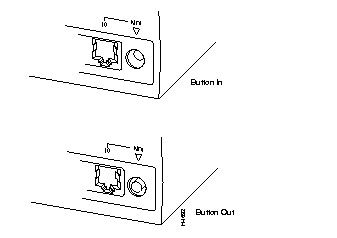
Because of different combinations of equipment and cables, you should refer to Table 4-2 to determine whether you should use the MDI or MDI-X setting:
| Device | Crossover Cable | Straight Cable |
| Hub (MDI-X) | MDI-X | MDI |
| Router | MDI | MDI-X |
| Server | MDI | MDI-X |
If you do need to order, or make a crossover cable, see the pin-outs in Appendix A.
This section explains how to connect a 10BaseT cable to a 10BaseT port on a Catalyst 3000.
 | Caution Do not touch the connector pins of connectors or cables. Static discharge may damage equipment. |
The Catalyst 3000 has 16 10BaseT ports. Connect them as follows:
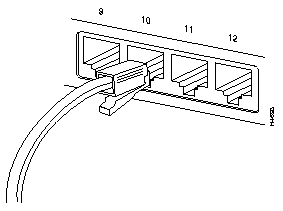
This section explains how to connect to the AUI port on the Catalyst 3000.
 | Caution Do not touch the hub connector pins or the cable connector pins. Static discharge may damage the equipment. |
To connect the AUI port to different media types, use an external transceiver. The Catalyst 3000 supports full-duplex Ethernet when connected to a transceiver supporting full-duplex.
The following section describes how to connect the AUI port on the Catalyst 3000 to an external transceiver.
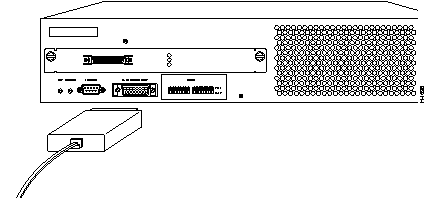
On Enhanced models, 10BaseT ports on the Catalyst 3000 can be set to either Half-Duplex or Full-Duplex communication mode. The mode can be set either by using software control, or by using the hardware DIP switches on the chassis back panel (see Figure 4-16). If the enhanced feature is not configured, then only half-duplex can be used. The enhanced feature and software mode setting must be set and verified through the console. See Chapter 7, "Console Configuration."
Contact your Cisco sales representative for information on how to obtain the enhanced software version.
Use the following steps when using the hardware switches to set full-duplex or half-duplex communication modes for the fixed 10BaseT ports:
Step 1 Locate the DIP switches on the rear panel as illustrated in the Figure 4-16:
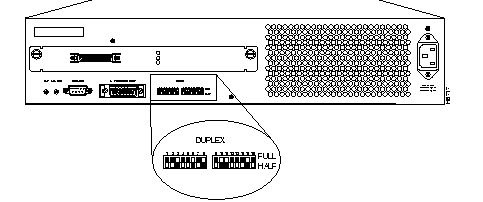
Step 2 Set the DIP switch for each port as follows:
| Half Duplex | Down |
| Full Duplex | Up |
Step 3 When power is applied to the Catalyst 3000, the switch settings will automatically take effect.
Step 4 The settings can be changed while the Catalyst 3000 is running. The new settings take effect right after you change the switch.
The LNK/FDX LED on the front panel is on when a half or full-duplex communications link has been established. The color of the LED responds to whether half or full-duplex:
| Green | Half-Duplex |
| Yellow | Full-Duplex |
Before you apply power, inspect the equipment thoroughly. Verify that all cables are installed correctly. Check their routing, so they are not damaged or create a safety hazard. Be sure all equipment is mounted properly and securely.
|
|